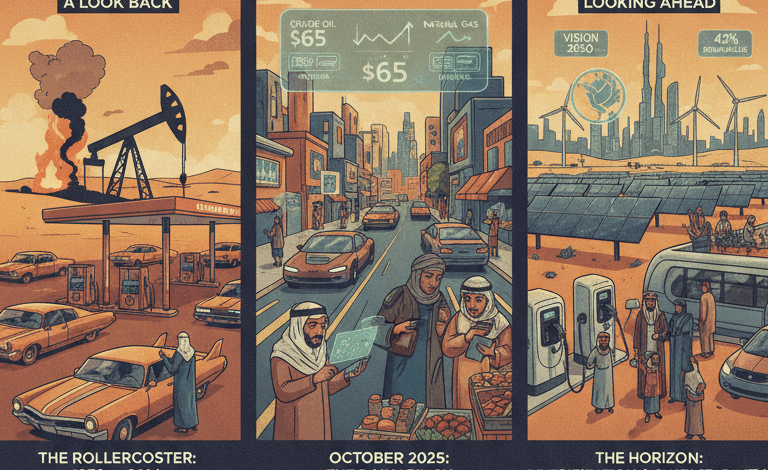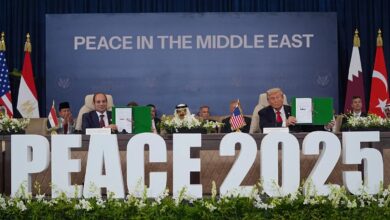How Rising Fuel Prices Are Affecting Arab Citizens in October 2025

1. Intro: The Daily Grind & The Price Tag
Ever felt that pinch at the petrol station? That nagging feeling that a significant chunk of your hard-earned cash is disappearing into the tank? For many in the Arab world, it’s more than a mere pinch—it’s a significant chunk of their daily budget, a constant recalculation of priorities. We’re diving into how fuel prices are shaping life for Arab citizens right now, in October 2025, from the mundane rhythm of daily commutes to the careful choices made at dinner tables. It’s a complex and often contradictory mix of global oil markets, deliberate governmental decisions, and the unyielding realities of everyday existence.
2. A Look Back: The Rollercoaster of Arab Fuel Prices
Fuel wasn’t always this weighty a consideration. Can you even recall a “golden age” of truly cheap petrol? Such memories likely predate the present.
- A Brief History: The narrative of fuel prices in the Arab world is punctuated by sharp, seismic shifts. The 1970s, for instance, delivered a one-two punch of economic upheaval.
- The 70s Shocks: The 1973 oil embargo, a direct consequence of the Yom Kippur War, and the 1979 Iranian Revolution sent prices skyrocketing across the globe, leaving few untouched.
- Gulf War Jitters (1990): The Iraqi invasion of Kuwait in 1990 ignited another conflict, sending further tremors through the oil markets and spiking prices once again.
- The Big Shift: However, the most profound transformation began post-2014. The era of artificially suppressed fuel costs, propped up by generous government subsidies, began to wane. Governments, particularly those of oil-exporting nations, started scaling back these benefits, initiating a period of gradual and sometimes jarring adjustments.
- IMF’s Influence: The International Monetary Fund (IMF) played a significant role, advocating for reform to alleviate the strain on national budgets and promote greater economic efficiency.
- Case Study – Saudi Arabia: Consider Saudi Arabia, a nation once synonymous with incredibly cheap fuel. Since 2010, prices have risen almost fivefold! There were considerable increases in 2015 and 2018. The government has since capped gasoline prices, providing a degree of stability, but diesel prices have seen considerable increases. Furthermore, the Kingdom recently reduced its official selling price (OSP) for crude oil destined for Asian markets, signaling strategic adjustments to its export policies.
- UAE Leads the Way: The United Arab Emirates (UAE) took a bold step in 2015, becoming the first among the Gulf Cooperation Council (GCC) countries to fully deregulate fuel prices, linking them directly to the fluctuating global markets.
- Egypt’s Ongoing Battle: Egypt has been engaged in a protracted struggle to phase out subsidies. Over ten price hikes since 2013, with the ambitious goal of completely eliminating subsidies by the end of 2025.
3. October 2025: What’s Happening at the Pump?
- Global Forecast: The Big Picture
- Crude Oil: Looking at the global picture, crude oil prices are generally trending downwards through late 2025 and into 2026. This anticipated decline is fueled by a combination of factors, including a projected oversupply in the market and a deceleration in global demand as electric vehicles gain traction. Brent crude, a key benchmark, is expected to hover in the $62-$65 per barrel range.
- Natural Gas: In stark contrast to crude oil, natural gas prices are experiencing an upward trajectory, driven by robust demand across various sectors.
- Regional Snapshot: It’s a Mixed Bag
- UAE: The UAE witnessed slight increases in both petrol and diesel prices for October. However, there are murmurs and anticipations of a potential drop in November, reflecting the nation’s adherence to a monthly price adjustment mechanism.
- Saudi Arabia: Gasoline prices remain capped, a deliberate policy decision by the Saudi government to shield consumers from volatility. However, diesel prices experienced substantial increases in both January 2024 and 2025.
- Egypt: In October, Egypt implemented another significant round of fuel price hikes, ranging from 10.5% to 12.9%, marking the second increase this year. Both diesel and petrol prices jumped. Then came a welcome surprise: a price freeze for the coming year.
- Oil Importers (e.g., Jordan, Morocco): Nations that rely on oil imports, such as Jordan and Morocco, are generally reaping the benefits of falling crude oil prices, leading to lower inflation projections and a welcome respite for their economies.
- Oil Exporters (e.g., GCC): Despite the downward trend in oil prices, oil-exporting economies, particularly those within the GCC, continue to experience growth. This resilience can be attributed to increased production levels and the diversification of their economies into non-oil sectors.
- Iran’s Looming Crisis: Iran faces a particularly precarious situation, grappling with the potential for a dramatic 300-500% increase in fuel prices if unsustainable subsidies are removed. This scenario represents a veritable ticking time bomb, with the potential to trigger widespread social unrest.
4. The Daily Impact: More Than Just a Number
- Wallet Woes: The Cost of Living
- Inflation Spike: Higher fuel costs invariably ripple through the economy, leading to a general increase in the price of goods and services. This inflationary pressure is particularly pronounced for food items, given the reliance on imported goods.
- Household Budgets: Families are forced to make difficult choices, re-evaluating their spending priorities and cutting back on non-essential items to accommodate rising fuel costs.
- Vulnerable Hit Hardest: Low-income households bear the brunt of these increases, as a larger proportion of their income is allocated to essential expenses like transportation and food.
- Getting Around: Transportation Troubles
- Car Dependency: Many Arab cities are characterized by urban planning models that heavily favor automobile use, with sprawling layouts, limited public transportation options, and climates that make walking or cycling less appealing. Fuel prices, therefore, have a direct and significant impact on daily commutes.
- Behavioral Shifts: Faced with rising costs, individuals are beginning to modify their behavior, driving less frequently, exploring more fuel-efficient vehicle options, or even considering relocating closer to their workplaces to shorten commutes.
- Public Transport: Even public transportation options, such as taxis and buses, become more expensive as operators pass on their increased fuel costs to passengers.
- Feeding Families: Food Security Concerns
- Import Reliance: Many Arab nations are heavily reliant on food imports. Higher fuel costs for shipping translate directly into higher prices on supermarket shelves.
- Disproportionate Impact: Regions already grappling with food insecurity and impoverished families are particularly vulnerable to these price increases, exacerbating existing challenges.
5. The Big Debates & Controversies
- To Subsidize or Not to Subsidize?: The Age-Old Question
- The Fiscal Drain: Fuel subsidies represent a substantial financial burden for governments, diverting crucial funds from essential sectors like education and healthcare.
- Inequality Issue: Wealthier individuals, who tend to consume more fuel, often disproportionately benefit from blanket subsidies, exacerbating existing inequalities.
- Environmental Costs: Cheap fuel encourages overconsumption, leading to increased pollution and hindering the adoption of more sustainable, renewable energy sources.
- Social Contract: Historically, low fuel prices have been viewed as an implicit part of the social contract between citizens and their governments. Disrupting this understanding can lead to social unrest and political instability.
- Geopolitics: The Unpredictable Factor
- Middle East Tensions: The Middle East, historically a volatile region, is prone to conflicts that can trigger sharp fluctuations in oil prices. Recent easing of tensions has contributed to price stabilization, but the peace remains fragile.
- Shipping Disruptions: Events such as attacks on ships in the Red Sea can significantly increase transportation costs, ultimately impacting fuel prices at the pump.
- The IMF’s Role: The “Tough Love” Approach
- Push for Reforms: The IMF consistently advocates for subsidy cuts as part of broader economic reform packages.
- Social Safety Nets: However, the IMF also emphasizes the importance of establishing targeted aid programs to protect vulnerable populations from the adverse effects of these reforms.
6. Looking Ahead: What’s on the Horizon?
- Economic Diversification: The Long Game
- Vision 2030 (Saudi Arabia): Saudi Arabia’s ambitious Vision 2030 plan entails massive investments in non-oil sectors like tourism, technology, and renewable energy, with the goal of reducing the Kingdom’s dependence on oil revenues. Fuel subsidy reforms are an integral component of this transformative vision.
- Egypt’s Energy Strategy: Egypt aims to generate 42% of its electricity from renewable sources by 2030, a strategic move to reduce its reliance on fossil fuels and enhance its energy security.
- Renewables on the Rise: A Greener Future?
- Growing Investment: The Arab region is witnessing a surge in investments in solar and wind power projects, signaling a commitment to a more sustainable energy future.
- EV Adoption: The global rise of electric vehicles will steadily erode oil demand, prompting further adjustments in the region’s energy landscape.
- The Ongoing Balancing Act:
- Governments face the delicate challenge of balancing fiscal health with social stability. Implementing targeted support programs is crucial to mitigating the adverse effects of reforms and ensuring their political palatability.
- Global market dynamics, geopolitical events, and the escalating pressures of climate change will continue to shape the Arab fuel landscape in the years to come.
7. Conclusion: Navigating the New Normal
October 2025 presents a snapshot of a region in constant flux, grappling with the multifaceted challenges of fluctuating fuel prices. These experiences are shaped by the intricate interplay of global markets and national policies. For Arab citizens, adapting to shifting fuel prices isn’t merely an economic adjustment; it’s a fundamental shift in their daily lives, prompting a collective push towards more sustainable and diversified futures.





